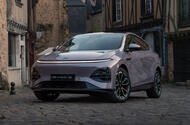How does the updated Xpeng G6 stack up against the Tesla Model Y in the UK?
If you’ve been eyeing the electric SUV market, you’ve probably noticed the Xpeng G6 making waves as a serious contender to the Tesla Model Y. The latest facelift brings more than just a fresh face—Xpeng has gone all-in on charging speed, claiming the new G6 could be the fastest-charging EV in its class. That’s a bold move, especially in a segment where every minute at the charger counts.
Let’s talk numbers. The G6’s maximum charging speed jumps from 280kW to a staggering 451kW. On paper, that means you could go from 10% to 80% battery in just 12 minutes. For context, most public chargers in the UK currently max out at 350kW, so you won’t always hit that theoretical peak. Still, even at 350kW, you’re looking at a seriously quick pit stop—faster than what most rivals can manage today.
What’s new in the design and interior?
Xpeng hasn’t just focused on what’s under the skin. The G6 now sports a full-width front light bar, a trend borrowed from its Tesla rival, giving it a more modern, high-tech vibe. The wheel arches are now colour-coded, the rear diffuser is sleeker, and there’s a subtle spoiler at the back. These aren’t just cosmetic tweaks—they help the G6 stand out in a crowded field of lookalike crossovers.
Inside, the updates are all about quality and comfort. You’ll find new wood-grain trim on the dashboard and improved materials throughout the cabin. For those who love a bit of tech, higher-spec models now offer a digital rear-view mirror. It’s the kind of detail that makes a difference on long drives or in tricky parking situations.
How does the new battery tech impact real-world range?
Here’s where things get interesting. The biggest-battery version of the updated G6 claims a range of 326 miles. That’s a bit less than the previous Long Range model, which boasted 354 miles. Why the drop? It looks like Xpeng is prioritizing faster charging and perhaps lighter weight over sheer battery capacity. In real-world terms, most drivers rarely need the full range in a single trip, but the ability to top up quickly could be a game-changer for road trips and busy lifestyles.
It’s worth noting that Xpeng hasn’t shared how long the battery can sustain those peak charging speeds. Battery health and longevity are always a concern with ultra-fast charging, so it’ll be interesting to see how the G6 performs over time. According to a 2023 study by the International Council on Clean Transportation, most modern EV batteries can handle frequent fast charging without significant degradation, but real-world data will tell the full story.
When can UK drivers expect to see the updated G6?
Orders are already open in Europe, with deliveries set for the end of summer. The UK importer, International Motors, hasn’t confirmed an exact arrival date, but a planned public debut at the Goodwood Festival of Speed suggests it won’t be long. If you’re eager to get behind the wheel, keeping an eye on Goodwood could be your best bet for an early look.
How does the G6 compare to other electric SUVs like the Audi Q6 E-tron?
Xpeng isn’t just targeting Tesla. The G6’s upgrades are mirrored in the flagship G9 SUV, which boasts an even higher peak charging speed of 530kW. That puts it in direct competition with premium models like the Audi Q6 E-tron, which is already on sale in Europe and expected to hit the UK soon. The takeaway? Xpeng is positioning itself as a leader in charging tech, not just value for money.
What’s the big takeaway for EV shoppers?
The electric SUV market is moving fast—sometimes literally. With the G6’s facelift, Xpeng is betting that UK drivers care as much about charging speed as they do about range or badge prestige. The result? A crossover that’s not just keeping up with the Teslas and Audis of the world, but in some ways, outpacing them.
The big takeaway? Choosing your next EV isn’t about perfection—it’s about smarter adjustments. Start with one change this week, whether it’s researching charging networks or booking a test drive, and you’ll likely spot the difference by month’s end.

